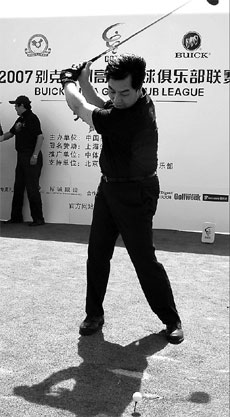Ten years ago, tennis in China was played only by a small elite. Now the nation has a group of world-class women's players and the sport is becoming increasingly popular in schools and communities.
The sport's success has given China's golf authorities a model to follow, and officials believe a similar miracle is possible.

Zhang Xiaoning, secretary-general of China Golf Association, tees off during the Buick China Golf Club League in Beijing last week. Zhang said he believes golf in China will follow tennis and become the next popular and successful sport. [China Daily]

|
Zhang Xiaoning, secretary-general of China Golf Association, tees off during the Buick China Golf Club League in Beijing last week. Zhang said he believes golf in China will follow tennis and become the next popular and successful sport. Wu Yu
Zhang Xiaoning, who was in charge of tennis until 2005, believes that golf is at a similar stage as tennis ten years ago.
"When I worked in the tennis administrative center ten years ago, lots of people thought of the sport as entertainment for the rich rather than a sport for common people," said Zhang, who is now director of the Multi-ball Games Administrative Center and Secretary-General of China Golf Association (CGA).
"Now, more and more people are playing tennis. Especially after China won the gold medal in women's doubles at the Athens Olympics, the sport gained nationwide popularity.
"I think we can make similar efforts to help change people's view of golf.
"First of all we should popularize the sport around China and make sure more and more people are able to play the sport.
"Secondly, we should produce some world-class players as soon as possible. Good results in big tournaments will encourage more young people to get involved."
CGCL tees off
To realize this target, CGA launched the Buick China Golf Club League (CGCL) in Beijing last week.
A total of 102 golf clubs from around China have registered to take part in the league, lasting nine months and involving nearly 20,000 participants.
"The launch of CGCL marks a milestone in the sport's development in China. We are aiming to bring all golf players together and then to encourage more people to join the sport," Zhang said.
The event will be a six-member team competition, and each team can only have one pro and must have one female player.
From May 19 to June 30, club member competitions will take place, with winners advancing into five zones - North, Mid-West, East, Mid-South and South. After approximately four months of competition, winners from different zones will battle it out in national finals in December.
"The gap (with the world's best) in women's golf is not as big as men's. So I think it is more likely our women's golf will have breakthroughs in the new future.
"The breakthrough in women's tennis has been inspiring the sport to a high profile status. I hope it will also happen in golf.
"Apart from the CGCL, we will double the number of women's competitions this year."
More and more elite golf tournaments have been introduced to China - six European Tour golf events took place last year on the mainland, but Zhang said it is the CGCL that will be pivotal to developing local golfing talents.
"In China, due to the lack of a grassroots system, youngsters' interest in the sport is mostly as a result of their parents' encouragement and financial support. I hope the CGCL will encourage clubs to play an important role in developing the grassroots sport.
"I am sure we will see a big number of new talents emerging from these competitions in the near future."
Star status
According to Zhang, there are 308 courses and more than 1 million golfers in China.
The increasing popularity of the sport has seen a group of Chinese players catapulted to star status, highlighted by the nation's first European Tour winners Zhang Lianwei and Liang Wenchong, who have become pro tour competitors and title contenders in world-class events.
But in Zhang's eyes, the number is too small.
"We need more and more young faces to appear in international tournaments. But many of them lack the chance of taking part in competitions when there are amateurs."
Zhang said South Korea is a good example for the nation to follow.
"A healthy sport is based on a solid grassroots level. South Korea has produced a large number of competitive players in pro tours because it has more than 2,800 pro athletes and 4,500 pro coaches. Compared to them, we still have a long way to go."
Zhang said CGA will set up three systems to focus on training, competitions and marketing.
The training system is made up of national teams in all levels. Amateurs and students are also the targets of the system.
In the competition system, CGA will increase the number of tournaments aimed at pros, amateurs, women and men. CGCL will become an important part of the system.
CGA will also play a leading role in the marketing system, in terms of offering services and consultation to sponsors and helping promote the sport.
Apart from the three systems, CGA will develop an increasing number of pro coaches, agencies, referees and caddies through co-operation with overseas organizations.